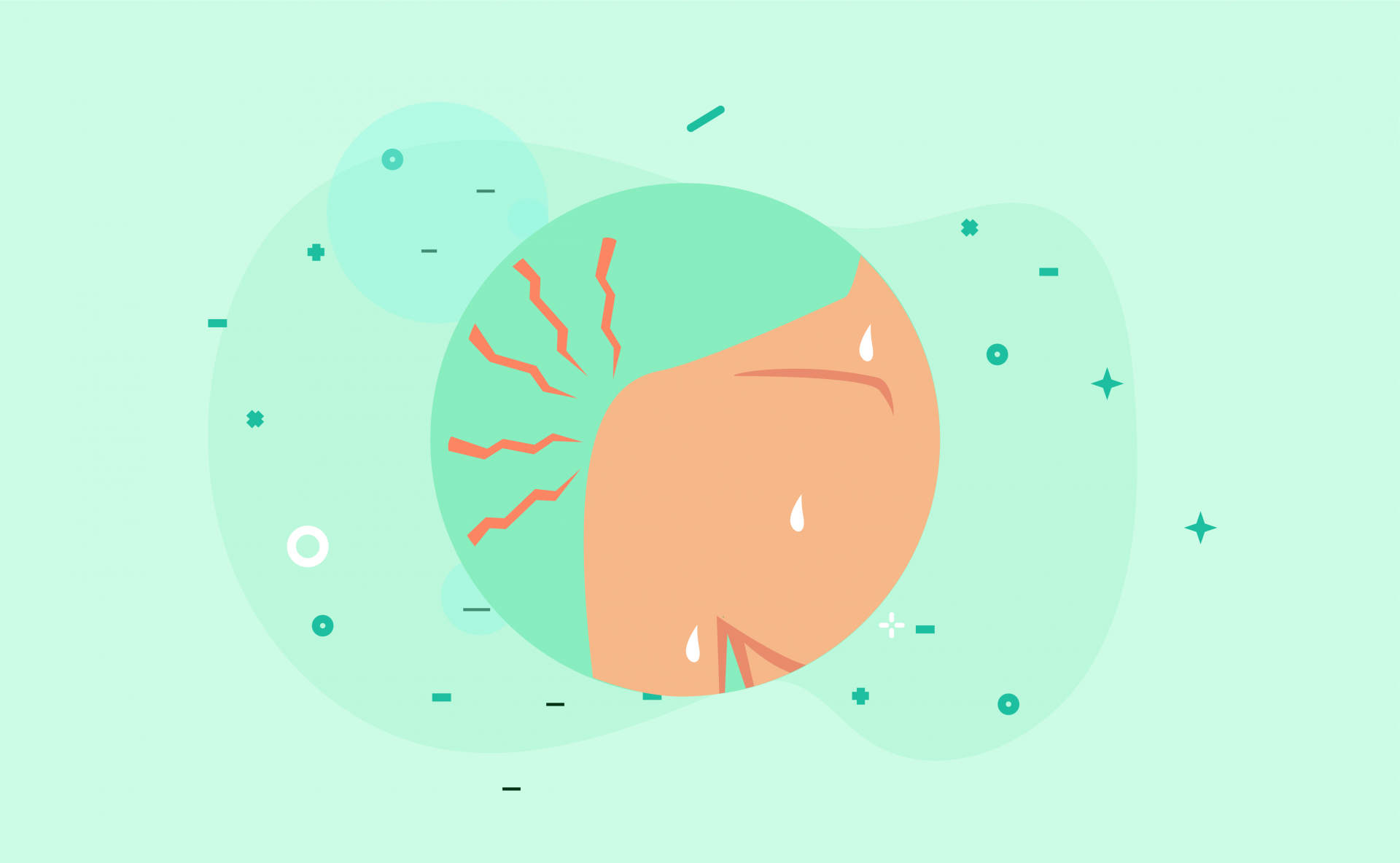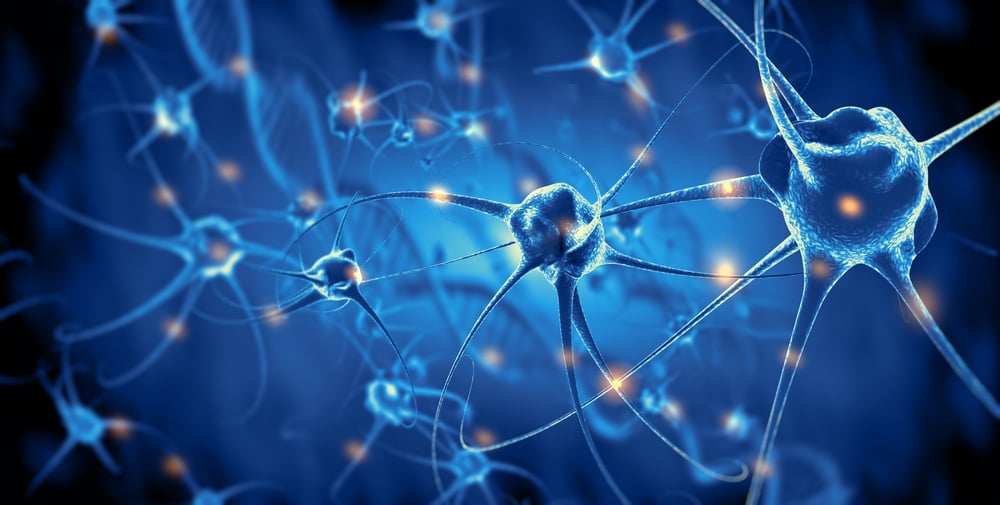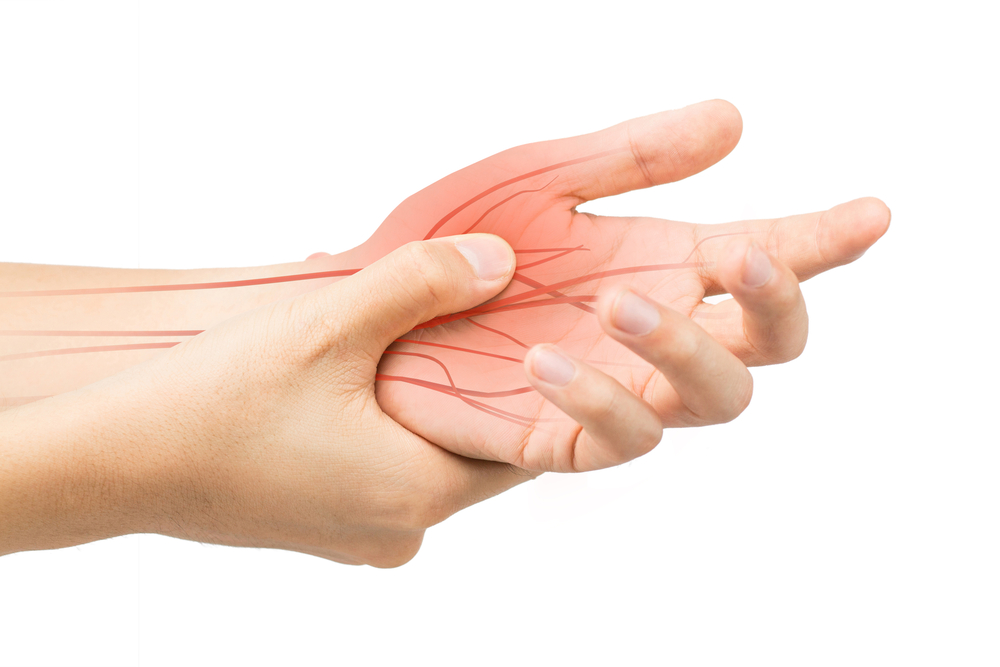| Total CBD: | 500 – 2500 mg |
| Potency: | 16.6 - 83.3 mg/mL |
| Cost per mg CBD: | $0.12 – $0.18 |
| Extract Type: | Full-spectrum |
| THC Content: | <0.3% |

Evidence based
Best CBD Oil For Nerve Pain: Benefits & Dosage For Neuropathic Pain
Neuropathic pain is notoriously difficult to treat.
Only 40% to 60% of patients able to find partial relief from their symptoms with conventional treatments.
Recent evidence suggests CBD oil may be a powerful natural treatment option for nerve-related pain.
Learn how it works & how to use it.
The human body is full of sensors leading to the brain. They sense temperature, touch, and tissue damage, and relay that information back to the brain for processing.
Neuropathic pain can be the result of damage to the nerves or pain sensors.
Learn what makes CBD so useful for treating neuropathic pain, how to use it effectively, and what other measures you can do to get the best chances of finding relief from your pain.
So, without further ado, let’s get into it.
Can CBD Oil Help With Neuropathic (Nerve) Pain?
CBD and other cannabinoids offer relief from various causes of neuropathic pain in humans [2, 3].
It offers most of these benefits through its ability to interact with the endocannabinoid system (ECS).
The ECS consists of a series of receptors and eicosanoids (called endocannabinoids) that regulate homeostasis (balance) throughout the body. There are endocannabinoid receptors found on virtually every organ in the human body, with the highest concentration in the central nervous system.
The endocannabinoid system functions like “read receipts” used in text messages.
When the nerves send a message, the receiving nerve cell uses the endocannabinoid system to tell the sending nerve that the message was received.
This system keeps the entire nervous system in constant feedback with itself and prevents sending the same message more than once — which is essentially what happens when we experience neuropathic pain.
CBD also supports nerve pain by reducing inflammation, activating the vanilloid pain receptors, and alleviating many of the common side effects of nerve pain.
The benefits of CBD oil for neuropathic pain include:
- Protects the nerve cells & brain
- Supports nerve cell regeneration
- Blocks pain transmission
- Regulates electrical activity in the brain
- Alleviates anxiety & depression
- Supports sleep

What’s The Effective Dose of CBD For Neuropathic Pain?
When it comes to treating neuropathic pain — a notoriously difficult type of pain to alleviate — a higher strength of CBD is generally recommended. Most of the research showing benefits from CBD noted an abnormally large dose of the compound to achieve this success.
For this reason, it’s a good idea to work out the dose yourself to find out what’s best for you and your symptoms.
You can use our CBD oil dosage calculator to find the best dose based on your weight and desired level of effects.
Start small and increase the dose every day until you either experience relief from symptoms — meaning you’ve found your dose — or experience side effects. If you experience side effects, you may need to dial the dose back to the last side-effect-free dose.
If you’re still not getting any reduction in pain symptoms with this dose, you may need to combine CBD with other forms of pain management — after consulting with a doctor, of course.
CBD Dosage Calculator
What Are The Side-Effects of CBD?
Although CBD has been proven to be highly safe many times over, it’s important to know about the potential side effects it may produce.
Everybody is different, and what works for one person doesn’t always work the same way for another.
Here are some of the most common side-effects of CBD:
- Appetite suppression
- Diarrhea
- Drowsiness
- Dry mouth
- Lightheadedness
- Lower heart rate
- Sedation

Which Type of CBD Should I Use?
CBD comes in all different forms — not all are going to work for every condition.
1. CBD Oils & Tinctures
CBD oils and tinctures provide the easiest methods of taking CBD. All you need to do is measure out the desired dose (more on this later) and pop it into your mouth. You can choose to hold the oil/tincture under your tongue for faster absorption or swallow it right away — both will work well.
2. CBD Capsules
CBD capsules are another excellent dosing option you can employ. Capsules are small and easy to carry, deliver standardized CBD doses, and have great bioavailability. They’re also an excellent option for people who don’t want to taste the CBD oil — which can have an earthy, undesirable taste in some cases.
3. Topical CBD Products
Topical CBD is another good option, but only if the source of your neuropathic pain is close to the surface of the skin. It’s recommended that you use it alongside internal forms of CBD, such as capsules, edibles, or oils. This is because the cannabinoids in topical CBD products won’t reach the spinal cord and brain where most of the pain relief comes from when treating neuropathic pain.
4. CBD Edibles
CBD Edibles, including gummies or baked goods, are certainly a fun way of taking CBD — but they’re often inconsistent with dosing (with the exception of gummies). The dosages listed are estimates, and the actual CBD content inside can vary significantly.
For this reason, we don’t recommend relying on CBD edibles as your everyday maintenance dose of CBD for neuropathic pain.
What is Neuropathic Pain?
Neuropathic pain is a type of pain involving damage to or dysfunction of the nerves and somatic sensors found throughout the body.
Any damage to or dysfunction of the nerves and sensory tissues can send pain signals to the brain. These signals warn the body of real damage or dysfunction, but they can also be caused by false messages sent to the brain.
These messages warn the brain of damage that may or may not exist. This makes neuropathic pain difficult to treat, especially when the underlying cause can’t be identified.
1. Central Neuropathic Pain
The central nervous system is any part of the nervous system inside the brain and spinal cord. This is separated from the peripheral nervous system by a semipermeable barrier called the blood-brain barrier.
Central neuropathic pain, therefore, involves pain originating from nerves located inside the central nervous system.
It’s caused by conditions such as:
- Multiple sclerosis
- Strokes
- Spinal cord injuries
2. Peripheral Neuropathic Pain
The peripheral nervous system involves any part of the nervous system outside of the brain and spinal cord. This includes all the nerves in the limbs, abdominal cavity, legs, and face.
Often, when a nerve becomes damaged, the repair process may not go as planned. Instead of returning the nerve to the way it was before the damage, the nerve becomes unusually sensitive and will send pain signals to the brain when it shouldn’t.
The original damage can happen from many different causes, primarily traumatic injuries or specific viruses that target the nerve cells directly — such as herpes virus or shingles.
This type of pain is caused by conditions such as:
- Diabetes
- Metabolic syndrome
- Herpes zoster infection
- HIV infection
- Nutritional deficiencies
- Environmental toxin exposure
- Cancer
- Autoimmune disorders
- Traumatic injuries

3. Mixed — Peripheral and Central Neuropathic Pain
Mixed neuropathic pain involves pain stemming from nerves found both inside the central nervous system and inside the peripheral nervous system.
Causes for mixed neuropathic pain include:
- Cancer
- Chemotherapy treatments
- HIV and other viral infections
- Heavy metal toxicity
What Are The Causes of Neuropathic (Nerve) Pain?
Neuropathic pain is caused by damage or dysfunction of the nerve cells. There are many causes for nerve damage in the body, such as:
- Multiple sclerosis
- Varicella-zoster infection
- Epstein Barr Virus infection (EBV)
- Traumatic injuries
- Trigeminal neuralgia
Treatments for Neuropathic Pain
- Antidepressants (SSRIs, SNRIs, and tricyclic antidepressants)
- Opiate pain medications (morphine, fentanyl, tramadol, and methadone)
- Surgical nerve blocks (severe cases only)
- Capsaicin
- Topical analgesics (lidocaine)
Related: Does CBD Interact With Tramadol?
CBD For Spinal Cord Injury
Spinal cord injuries can have debilitating and life-altering consequences. Injuries can cause varying levels of paralysis, spasticity, loss of sensation, muscle weakness, and nerve pain that can persist for the rest of that person’s life.
There are some treatments available for this condition, most of which are supportive — helping those affected manage pain, depression, and other side-effects of the condition.
CBD cannot cure a spinal cord injury — however, it does likely offer a great deal of support for those affected by managing symptoms and promoting the repair of nerve cells in the damaged areas of the spinal cord.
There’s also some indication that CBD can support the recovery process — lowering the severity of side effects and improving motor function in the affected nerves [5].
The Benefits of CBD Oil For Spinal Cord Injury Includes:
- Managing chronic pain
- Relieving symptoms of mild to moderate depression
- Adjunctive treatment to prevent antibiotic resistance during lung infection
- Alleviating insomnia
- Promoting nerve regeneration
- Possibly reducing the extent of nerve damage from the incident
What is a Spinal Cord Injury?
The spinal cord is an extension of the brain. It contains high concentrations of nerve cell tracts that send and receive messages between the body and the brain. Any damage to the spinal cord can result in serious consequences, including paralysis, spasms, neuropathic pain, or loss of organ function.
The spinal cord contains millions of nerve “intersections” that distribute signals to every part of the body. The area of the spinal cord that is damaged will determine what side-effects develop and where.
For example, if the region of the spine containing the nerves that control leg muscles is damaged, it means that there will be a weakness or complete loss of function in those muscles and sensory deficits in one or both legs.
Spinal Cord Injury Symptoms
- Paralysis/Weakeness
- Motor deficits
- Sensory deficits (of pain, touch, temperature, location, and vibration senses)
- Bedsores from prolonged immobility
- Changes in mood
- Chronic pain
- Difficulty breathing
- Frequent infections
- Headaches
- Incontinence
- Infertility
- Muscle pain
- Nerve pain
- Pneumonia
- Poor libido
Types of Spinal Cord Injury
Depending on how severe the injury is, there are three main classifications that doctors use to describe the condition:
- Incomplete spinal cord injury — involves damage that hasn’t completely inhibited nerve transmission past the site of injury.
- Complete spinal cord injury — damage to the spinal cord is severe enough that no nerve signals can pass across the site of injury.
- Brown Séquard Syndrome— damage to exactly one half section of the cord, either left or right hemisection.
There are also several other types of spinal cord injury such as dorsal column lesion, irregular lesions, small or large central lesion, tumor of the dorsal root, or tumor of the meninges or bone.
The Location of the Spinal Cord Injury Matters
Nerves leave the brain and head down the spinal cord in bundles and pairs. They branch off at various points along the way to go to their target organs, and some tracts will cross sides.
The location of the damage to the spinal cord will determine which areas of the body are affected.
Complete damage of the spinal cord will prevent all nerves below the damaged point to stop receiving or sending messages. Therefore, to classify the level of injury, doctors will assess the lowest levels of different sensations and functions of the nerves in the spinal cord.
There are four main divisions of the spinal cord — organized according to the vertebral column. The vertebral column starts at one at the base of the skull and goes all the way to the coccyx. The spinal cord, in fact, actually ends between vertebrae L1-L2, and is followed by a bundle of nerves called the cauda equina the rest of the way down.
Causes of Spinal Cord Injuries
- Car accidents
- Gunshot wounds
- Stab wounds
- Tumor growths
- Sports injuries
- Toxic exposure
- Ischemic damage
What the Research Says
In 2012, researchers conducted a study on the use of CBD for spinal cord injuries in rats [5]. Rats were either placed in the treatment group and given CBD, or into the control group where no treatment was given. At the end of the six-day study, rats in the CBD treatment group had significant improvements in motor function and reduced injury side-effects than rats in the no-treatment group. Therefore, the researchers conducting this study concluded that CBD might be a useful treatment option for spinal cord lesions (injuries).
Another study used a survey that was handed out to 10 spinal cord injury patients at the Spinal Cord Injury ward of the Miami V.A. Hospital who were using marijuana to treat their symptoms. The survey was kept confidential and involved questions about the most common symptoms of the condition and how marijuana use affected them.
Results of This Survey Listed:
| Symptoms | Made Worse | Made Better | No Effect | Distraction | Not Applicable |
| Phantom Pain | 1 | 4 | 2 | 2 | 1 |
| Muscle Spasticity | 0 | 5 | 3 | 0 | 2 |
| Bladder Spasms | 1 | 1 | 7 | 0 | 1 |
| Urinary Retention | 2 | 0 | 8 | 0 | 1 |
| Headaches | 0 | 5 | 4 | 0 | 1 |
THC has also offered benefits for spinal cord injuries. For this reason, a full-spectrum cannabis extract containing both CBD and THC is considered the best option.
Potential Benefits of THC for Spinal Cord Injuries
- Reduces muscle spasms involved with spinal cord injuries [6]
- Improves bladder control in spinal cord injuries [7]
- Reduces pain associated with spinal cord injuries [8]
THC remains illegal throughout most of the world, so it may be difficult to find products containing more than 0.3% THC concentration. Further robust studies will be needed to better characterize standard effects and determine efficacy.
Related: Best CBD:THC Ratio for Neuropathy.

Key Takeaways: Does CBD Oil Work For Neuropathic Pain?
The causes of neuropathic pain can range from neurological issues such as multiple sclerosis or a stroke to nutritional deficiencies and diabetes.
No matter what’s causing neuropathic pain, the benefits of CBD remain much the same.
CBD can support neuropathic pain in the following ways:
- Increases anandamide levels
- Activates the vanilloid receptors
- Inhibits inflammation that may be causing neuropathic pain
- Mildly activates the opioid receptors in the spinal cord and brain
When it comes to treating neuropathic pain, a higher dose is usually recommended — however, this can vary from person to person. Whenever using CBD for the first time, it’s wise to start low and increase slowly over time until you receive the benefits you’re looking for.
References
- Dworkin, R. H., O’connor, A. B., Backonja, M., Farrar, J. T., Finnerup, N. B., Jensen, T. S., … & Portenoy, R. K. (2007). Pharmacologic management of neuropathic pain: evidence-based recommendations. Pain, 132(3), 237-251.
- Leung, L. (2011). Cannabis and its derivatives: review of medical use. The Journal of the American Board of Family Medicine, 24(4), 452-462.
- Grotenhermen, F., & Müller-Vahl, K. (2012). The therapeutic potential of cannabis and cannabinoids. Deutsches Ärzteblatt International, 109(29-30), 495.
- Bisogno, T., Hanuš, L., De Petrocellis, L., Tchilibon, S., Ponde, D. E., Brandi, I., … & Di Marzo, V. (2001). Molecular targets for cannabidiol and its synthetic analogues: effect on vanilloid VR1 receptors and on the cellular uptake and enzymatic hydrolysis of anandamide. British journal of pharmacology, 134(4), 845-852.
- Kwiatkoski, M., Guimaraes, F. S., & Del-Bel, E. (2012). Cannabidiol-treated rats exhibited higher motor score after cryogenic spinal cord injury. Neurotoxicity Research, 21(3), 271-280.
- Hagenbach, U., Luz, S., Brenneisen, R., & Mäder, M. (2003, September). The treatment of spasticity with D9-tetrahydrocannabinol (D9-THC) in patients with spinal cord injury. In IACM 2nd Conference on Cannabinoids in Medicine (pp. 12-13).
- Hagenbach, U., Gafoor, N., & Brenneisen, R. (2001, October). Clinical investigation of delta-9-tetrahydrocannabinol (THC) as an alternative therapy for overactive bladders in spinal cord injury patients. In Cologne, Germany: Congress on Cannabis and Cannabinoids.
- Hagenbach, U., Luz, S., Ghafoor, N., Berger, J. M., Grotenhermen, F., Brenneisen, R., & Mäder, M. (2007). The treatment of spasticity with Δ 9-tetrahydrocannabinol in persons with spinal cord injury. Spinal cord, 45(8), 551.
- Maurer, M., Henn, V., Dittrich, A., & Hofmann, A. (1990). Delta-9-tetrahydrocannabinol shows antispastic and analgesic effects in a single case double-blind trial. European archives of psychiatry and clinical neuroscience, 240(1), 1-4.
- Malec, J., Harvey, R. F., & Cayner, J. J. (1982). Cannabis effect on spasticity in spinal cord injury. Archives of Physical Medicine and Rehabilitation, 63(3), 116-118.
- Dunn, M., & Davis, R. (1974). The perceived effects of marijuana on spinal cord injured males. Paraplegia, 12(3), 175-178.
More Health Benefits to Explore
-
Conditions Related to Health Benefits
- CBD For Allergies: Can This Cannabinoid Ease Symptoms?
- Top 10 CBD Oils For Back Pain
- Can CBD Help With Menstrual Cramps?
- CBD for Sciatica: How It Works, Safety, Drug Interactions, & Best Products
- Is CBD a Viable Treatment for Cerebral Palsy?
- CBD Oil For Sleep
- CBD For Psoriasis: Can CBD Help to Alleviate Symptoms?
- Traumatic Brain Injury (TBI)
- Arthritis
- Anxiety & Depression
- Weight Loss
- ADD & ADHD
- Anorexia
- Alzheimer’s Disease & Dementia
- Addiction
- ALS (Amyotrophic Lateral Sclerosis)
- Antibiotic Resistance
- Asthma
- Atherosclerosis
- Autism
- Acne
- Bipolar Disorder
- Pain
- Crohn's Disease & Ulcerative Colitis
- Diabetes
- Epilepsy
- Endocrine Disorders
- Fibromyalgia
- Fatty Liver Disease
- Glaucoma
- Hypertension
- Heart Disease
- Huntington's Disease
- Inflammation
- Irritable Bowel Syndrome (IBS)
- Kidney Disease
- Migraine Headaches
- Muscle Recovery
- Multiple Sclerosis
- Motion Sickness
- Metabolic Syndrome
- Neurodegeneration
- Cancer
- Nausea
- Neuropathic (Nerve) Pain
- Osteoporosis/Bone Health
- Obsessive-Compulsive Disorder (OCD)
- Polycystic Ovarian Syndrome (PCOS)
- PTSD
- Prion/Mad Cow Disease
- Premenstrual Syndrome (PMS)
- Parkinson’s Disease
- Schizophrenia
- Sickle Cell Anemia
- Stroke
-
Conditions Related to Products
- Ranking The Top 13 THC Gummies By Category (Δ8, Δ9, Δ10, HHC, & More)
- Top 10 CBD Oils For Back Pain
- Everything You Need to Know About CBD Sunscreen
- Top 7 CBD Gummies For Sleep & Insomnia
- Top 7 CBD Gummies To Help With Anxiety (2022)
- Best CBD Gummies For Pain (Top-Rated Pain Gummies For 2022)
- Best Hemp Cigarettes (Top 5 Nicotine-Free Smokes)
- Top 5 CBD Lip Balms For 2022
- The Top 7 CBD Face Masks for 2022
- The Best CBD Inhalers For 2022 (& How to Use Them)
- Best Full-Spectrum CBD Vape Juice: What to Look For & How to Use It
- CBD Eye Drops: New Option For Glaucoma?
- CBD Oil For Dogs With Arthritis
- Best CBD Massage Oils In 2022
- Buyer's Guide To The Best CBD Vape Kits In 2022
- CBD Chocolate: Yes, It Exists & It's Just as Divine as it Sounds
- CBD Pre-Rolls & Cigarettes
- Terpene Concentrates
- Best CBD Soaps
- Best CBD Shampoo & Conditioner
- Best CBD Juul Pods
- CBD Isolate Oils
- Full-Spectrum CBD Oils
- Best CBD Lube
- CBD Honey
- CBD Transdermal Patches
- Best Dry Herb Vaporizers
- CBD Oil For Dogs With Epilepsy
- CBD Oil For Dogs With Anxiety
- CBD Oil For Dogs With Cancer
- CBD For Horses
- CBD Chewing Gum
- CBD Pain Cream
- CBD Oil For Cats
- CBD Oil For Dogs
- CBD Hemp Flower
- CBD Suppositories
- Best CBD Gummies for Pain, Sleep & Anxiety Reviewed (2022)
- CBD Teas
- CBD Vape Pens
- CBD Vape Oils
- CBD Coffee
- CBD Drinks & Shots
- CBD Crystals
- CBD Skincare
- Best CBD Oil & Gummies For Kids: Is CBD Safe for Children with Anxiety & ADHD?
- CBD Concentrates
- CBD Bath Bombs
- CBD Capsules
- CBD Sprays
- CBD Dog Treats
-
Conditions Related to Topicals
-
Conditions Related to Oils & Tinctures
-
Conditions Related to Edibles
- Top 7 CBD Gummies To Help With Anxiety (2022)
- Best CBD Gummies For Pain (Top-Rated Pain Gummies For 2022)
- CBD Chocolate: Yes, It Exists & It's Just as Divine as it Sounds
- CBD Honey
- CBD Chewing Gum
- Best CBD Gummies for Pain, Sleep & Anxiety Reviewed (2022)
- CBD Teas
- CBD Coffee
- CBD Drinks & Shots
- CBD Capsules
-
Conditions Related to Gummies
- Ranking The Top 13 THC Gummies By Category (Δ8, Δ9, Δ10, HHC, & More)
- Top 7 CBD Gummies For Sleep & Insomnia
- Top 7 CBD Gummies To Help With Anxiety (2022)
- Best CBD Gummies For Pain (Top-Rated Pain Gummies For 2022)
- Best CBD Gummies for Pain, Sleep & Anxiety Reviewed (2022)
- Best CBD Oil & Gummies For Kids: Is CBD Safe for Children with Anxiety & ADHD?
-
Conditions Related to Hemp Flower
-
-
Conditions Related to Terpenes
-
-
Conditions Related to Cultivation
-
Conditions Related to Concentrates
-
Conditions Related to Delta 8 THC
-
Conditions Related to Delta 9 THC
-
-
-
-
Conditions Related to CBD
- Everything You Need to Know About CBD Sunscreen
- Top 7 CBD Gummies For Sleep & Insomnia
- Top 7 CBD Gummies To Help With Anxiety (2022)
- Best CBD Gummies For Pain (Top-Rated Pain Gummies For 2022)
- Best Hemp Cigarettes (Top 5 Nicotine-Free Smokes)
- Top 5 CBD Lip Balms For 2022
- The Top 7 CBD Face Masks for 2022
- The Best CBD Inhalers For 2022 (& How to Use Them)
- Best Full-Spectrum CBD Vape Juice: What to Look For & How to Use It
- CBD Eye Drops: New Option For Glaucoma?
- CBD Oil For Dogs With Arthritis
- Best CBD Massage Oils In 2022
- Buyer's Guide To The Best CBD Vape Kits In 2022
- CBD Chocolate: Yes, It Exists & It's Just as Divine as it Sounds
- CBD Pre-Rolls & Cigarettes
- Best CBD Soaps
- Best CBD Shampoo & Conditioner
- Best CBD Juul Pods
- CBD Isolate Oils
- Full-Spectrum CBD Oils
- Best CBD Lube
- CBD Honey
- CBD Transdermal Patches
- CBD Oil For Dogs With Epilepsy
- CBD Oil For Dogs With Anxiety
- CBD Oil For Dogs With Cancer
- CBD For Horses
- CBD Chewing Gum
- CBD Pain Cream
- CBD Oil For Cats
- CBD Oil For Dogs
- CBD Hemp Flower
- CBD Suppositories
- Best CBD Gummies for Pain, Sleep & Anxiety Reviewed (2022)
- CBD Teas
- CBD Vape Pens
- CBD Vape Oils
- CBD Coffee
- CBD Drinks & Shots
- CBD Crystals
- CBD Skincare
- Best CBD Oil & Gummies For Kids: Is CBD Safe for Children with Anxiety & ADHD?
- CBD Concentrates
- CBD Bath Bombs
- CBD Capsules
- CBD Sprays
- CBD Dog Treats
-
-
Conditions Related to THC-O
-
-
Conditions Related to Joint Health
-
Conditions Related to Pain Disorders
- Top 10 CBD Oils For Back Pain
- Can CBD Help With Menstrual Cramps?
- CBD for Sciatica: How It Works, Safety, Drug Interactions, & Best Products
- Traumatic Brain Injury (TBI)
- Arthritis
- Pain
- Fibromyalgia
- Glaucoma
- Inflammation
- Kidney Disease
- Migraine Headaches
- Multiple Sclerosis
- Neuropathic (Nerve) Pain
- Premenstrual Syndrome (PMS)
- Sickle Cell Anemia
-
Conditions Related to Autoimmune Disease
-
Conditions Related to Cognitive Health
-
Conditions Related to Metabolic Disorders
-
Conditions Related to Psychological Disorders
-
Conditions Related to Muscles & Bones
-
Conditions Related to Nervous System
- CBD for Sciatica: How It Works, Safety, Drug Interactions, & Best Products
- Is CBD a Viable Treatment for Cerebral Palsy?
- CBD Oil For Sleep
- Traumatic Brain Injury (TBI)
- Anxiety & Depression
- ADD & ADHD
- Anorexia
- Alzheimer’s Disease & Dementia
- Addiction
- ALS (Amyotrophic Lateral Sclerosis)
- Autism
- Bipolar Disorder
- Epilepsy
- Huntington's Disease
- Inflammation
- Migraine Headaches
- Multiple Sclerosis
- Motion Sickness
- Neurodegeneration
- Neuropathic (Nerve) Pain
- Obsessive-Compulsive Disorder (OCD)
- PTSD
- Prion/Mad Cow Disease
- Parkinson’s Disease
- Schizophrenia
-
-
Conditions Related to Reproductive Health
-
Conditions Related to Hormones & Endocrine
-
Conditions Related to Skin Health
-
Conditions Related to Cardiovascular System
-
Conditions Related to Digestive System
-
Conditions Related to Genetic Disorders
-
Conditions Related to For Children









